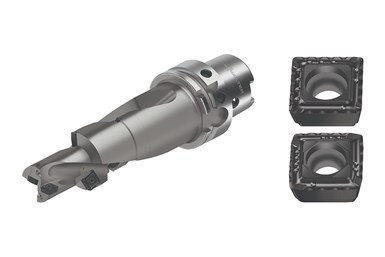Walter’s Drilling Grade for Drilling Aluminum
This grade is designed to enable reliable chip removal due to its smooth surface with a reduced tendency toward adhesion and buildup on the cutting edge, thereby increasing process reliability and wear resistance.
Walter’s PVD drilling WNN15 grade for indexable insert drills is designed as a reliable, low-adhesion grade indexable insert drill. It is said this grade can be used specifically for drilling in tough ISO N materials such as wrought aluminum alloys or cast aluminum alloys. Primary areas of application include aerospace, automotive and general machining when weight reduction is key.
The grade is said to provide reliable chip removal due to its smooth surface with a reduced tendency toward adhesion and buildup on the cutting edge to offer process reliability and wear resistance for longer tool life, even at extremely high cutting speeds. This means that it can make indexable insert drilling more cost-effective than comparable PCD tools, the company says,
The indexable insert drills are said to offer the advantage of multiple indexing, which means the tool can be used again immediately and with comparably lower costs and less time required. It is said worn indexable inserts can be replaced quickly and easily.
This grade features a hard substrate on the indexable inserts, which is said to promote high cutting-edge stability. The PVD coating is created using the HiPIMS process, making a smooth, dense surface leading to a rake face surface that is said to perform better than a polished carbide surface.
An increase in the tool life of up to 200% can be achieved, depending on the application, compared to conventional drilling grades, the company says. The WNN15 drilling grades are available for most of the indexable insert drills in Walter’s portfolio, including D4120 (sizes 1-8), D3120 (sizes 1-7), and B3212.DF-B3214-DF (0.394-0.709 in. and 10-18 mm).
Related Content
-
What Is Trochoidal Turning? How Might Shops Benefit From It?
While trochoidal milling might be a more well-known toolpath strategy, trochoidal turning can offer similar benefits such as high material removal rates especially for rough-turning operations.
-
Repeatability and Rigidity Are Key for Quick-Change Swiss Tooling
A rotary wedge clamping system is said to enable this two-piece, modular tooling system for Swiss-types to offer the performance of a solid tool.
-
The Ins and Outs of Inserts
Understanding how inserts are made provides valuable insight into how their performance can be optimized.

















